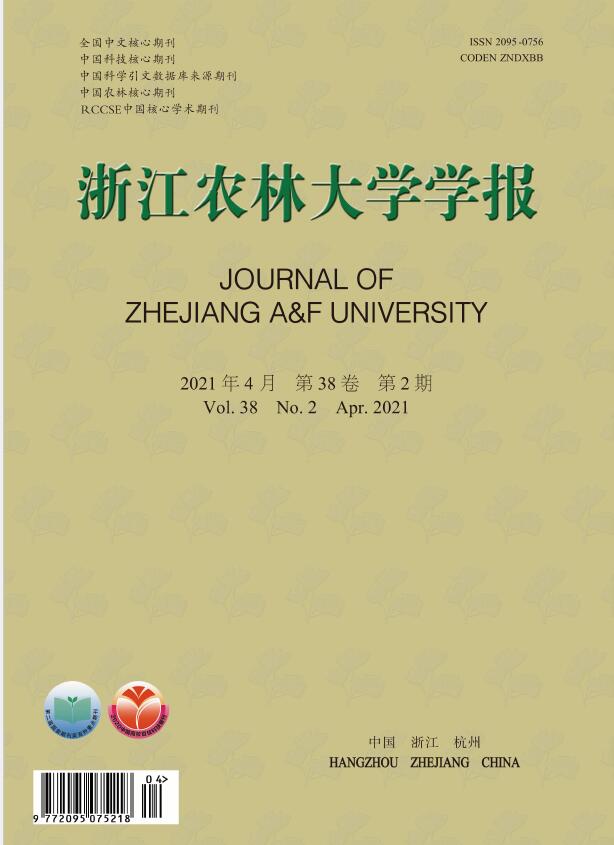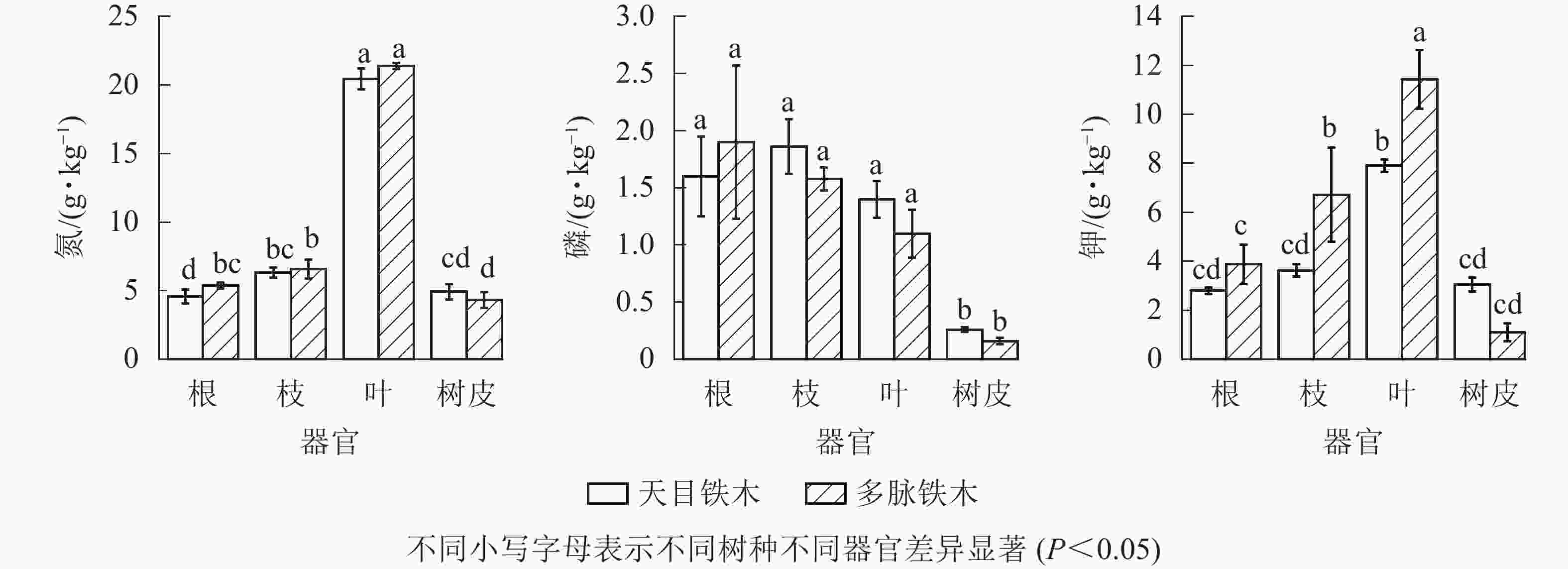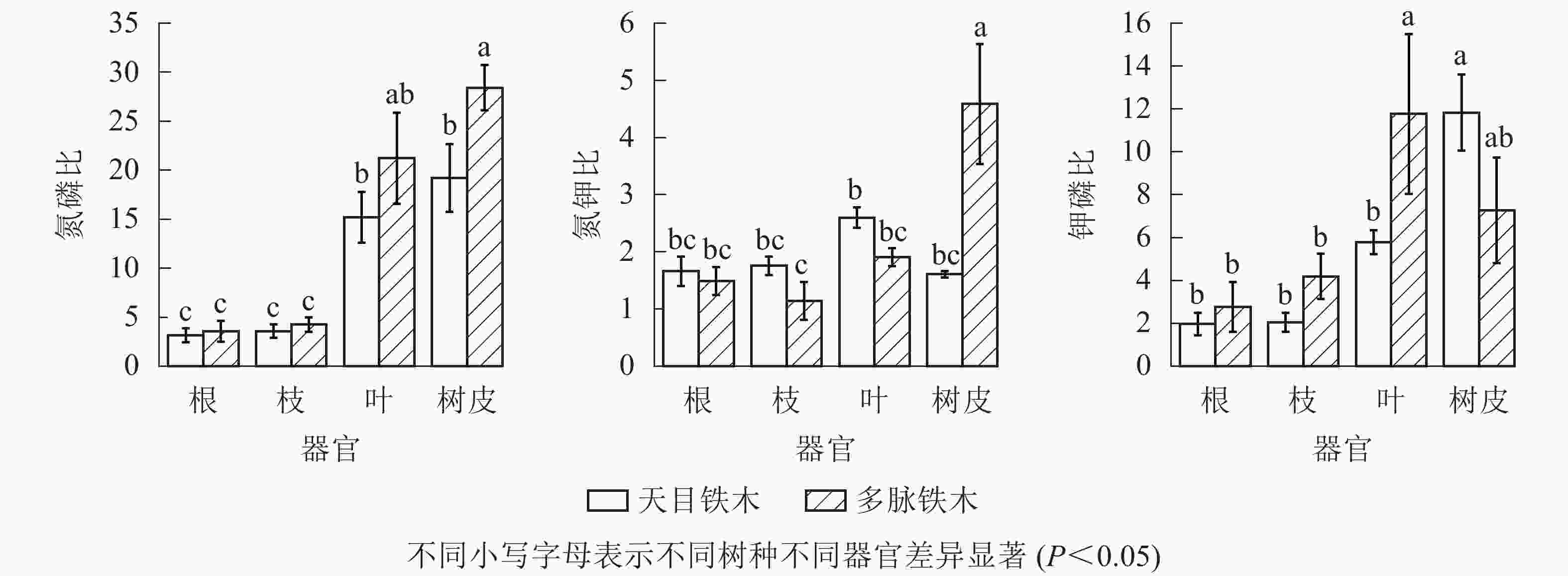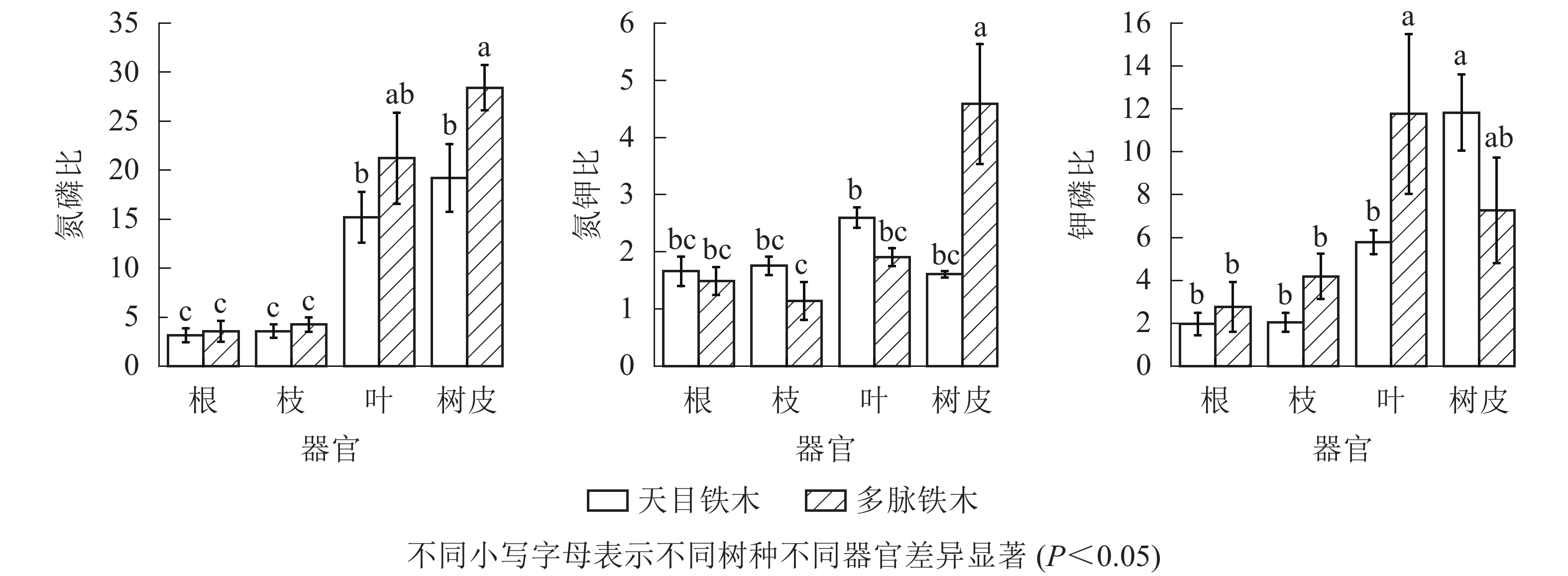-
氮、磷、钾是植物生长发育的必需营养元素。植物体内的氮、磷、钾含量分布及其生态化学计量特征能够反映植物对各器官营养元素的分配及相互作用关系,对判断限制性营养元素、养分利用情况等具有重要作用[1−3],是当前生态学研究的主要内容和热点[4−7]。桦木科Betulaceae铁木属Ostrya植物在全世界共有7种,其中中国自然分布的有4种,而浙江省境内仅见2种,即天目铁木Ostrya rehderiana和多脉铁木O. multinervis。天目铁木为国家二级保护树种,现有野生大树仅5株[8],生长于杭州市临安区天目山镇,多脉铁木仅分布于文成县石垟林场,野生株数118株[9],是浙江省重点保护野生植物。铁木属植物具有树体高大,干形通直圆满,材质优良的特点。国内学者已对天目铁木和多脉铁木的生育、繁殖、遗传、栽培等方面进行了一定的研究[10−17]。目前,国内外缺少有关天目铁木和多脉铁木这2种珍稀植物不同器官营养元素含量及生态化学计量差异的研究。掌握天目铁木与多脉铁木生长对元素的需求情况,可以提供针对性的施肥方案,有助于天目铁木与多脉铁木的正常生长与繁育。本研究对2种铁木属植物根系、枝条、叶片、树皮的氮磷钾质量分数以及根区土壤的基本理化性质进行研究,探究2种铁木属植物的生态化学计量特征与差异,旨在为这2种植物的生存繁衍提供适合的营养管理方案,为扩大其种群数量提出合理的措施。
HTML
-
天目铁木研究区位于杭州市临安区西天目山,中心位置为30°17′N,119°27′E。属北亚热带季风气候,年平均气温为14.8 ℃;最冷月为1月,月平均气温3.4 ℃;最热月为7月,月平均气温为28.1 ℃。年降水量1390.0 mm,年日照时数1550.0 h,无霜期235.0 d[18]。土壤类型属于凝灰岩发育的红壤土类。
多脉铁木研究区位于文成县石垟林场,分布中心地理位置为27°50′N,119°50′E。属中亚热带季风气候,年平均气温为12.8 ℃;最冷月为1月,月平均气温为4.0 ℃;最热月为7月,月平均气温为23.6 ℃。年降水量1604.0 mm,年均相对湿度84.0%,年日照时数1755.0 h,全年无霜期288.0 d[19]。该区域属原始次生常绿阔叶林,森林覆盖率达90%以上。多脉铁木群落分布区域的海拔为500~700 m,坡度30°~35°,南坡和坡中部地表有石块层覆盖,厚度20~30 cm,石块大小20~40 cm[20]。土壤类型为发育于花岗岩的红壤土类。2种铁木属植物根区土壤均为酸性土壤,其理化性质如表1。
树种 pH 碱解氮/(mg·kg−1) 有效磷/(mg·kg−1) 速效钾/(mg·kg−1) 有机碳/(g·kg−1) 天目铁木 6.26±0.03 a 166.4±2.67 a 5.25±0.38 a 158.5±1.48 a 24.1±0.23 A 多脉铁木 5.55±0.18 b 137.3±9.65 b 4.45±0.61 a 152.3±1.69 b 16.1±0.14 B 说明:表中同列小写字母表示不同树种土壤间差异显著(P<0.05),同列大写字母表示不同树种土壤间差异极显著(P<0.01) Table 1. Basic physical and chemical properties of soil in O. rehderiana and O. multinervis woodlands
-
在研究区对天目铁木和多脉铁木群落展开调查,测量胸径和株高。选取地径和株高均为平均值的植株各3株[21],分别采集2种铁木属植物东、南、西、北带叶枝条各1根,包括当年生和多年生枝条,长度为(50.0±5.0) cm,枝径为(0.5±0.1) cm。随机均匀采集距离地面1.0 m高的2种植株树皮样品,采集后均匀混合。根系的取样以样本植株为中心,分别以0.5 m为半径,挖取深度为30.0 cm,宽度为50.0 cm的土壤剖面,采集剖面中的所有根系。
-
植物样品用去离子水洗净,置于烘箱中105 ℃杀青30 min,然后在80 ℃条件下烘干至恒量[22−23],取出,用高速粉碎机将样品粉碎,过0.149 mm筛后,分别装袋编号,待用。土壤有机质的测定采用重铬酸钾容量法,土壤碱解氮的测定采用碱解扩散法,土壤有效磷的测定采用钼蓝比色法,土壤速效钾的测定采用火焰光度计法;植物样品经过H2SO4-H2O2处理,全氮采用半微量开氏法,全磷采用钼蓝比色法,全钾采用火焰光度法。
-
数据均采用Excel 2016及SPSS 22.0软件整理,采用单因素方差分析的最小显著差异(LSD)法进行差异显著性检验及相关性分析。图表绘制采用Origin 2018软件处理。
1.1. 研究区概况
1.2. 研究方法
1.2.1. 采样方法
1.2.2. 样品处理与测定
1.2.3. 数据整理与分析
-
由图1可见:氮、磷、钾在2种铁木属植株不同器官之间的差异较为显著。叶片中氮质量分数均为最高,显著高于根、枝和树皮(P<0.05)。2种铁木的枝、叶、树皮相同器官之间相比,氮质量分数并无显著性差异(P>0.05),仅多脉铁木的根氮质量分数显著高于天目铁木(P<0.05)。2种铁木的根、枝中磷质量分数最高,树皮中磷质量分数显著低于根、枝和叶(P<0.05)。但是2种铁木的根、枝、叶和树皮相同器官之间相比,磷质量分数并无显著性差异(P>0.05)。2种铁木的叶中钾质量分数最高,树皮中钾质量分数显著低于叶(P<0.05)。其中多脉铁木的根、枝、叶中钾质量分数都高于天目铁木,特别是枝和叶,钾质量分数都显著高于天目铁木的枝、叶(P<0.05)。但是多脉铁木的树皮中钾质量分数略低于天目铁木,但无显著性差异(P>0.05)。总体看来,多脉铁木植株中钾质量分数高于天目铁木。
树皮中的氮、磷、钾元素的质量分数较低,而叶片的氮和钾质量分数远大于其他器官,根和枝的各元素质量分数较为接近。2种铁木相同器官之间相比,仅多脉铁木根中的氮和叶、枝中的钾显著高于天目铁木(P<0.05)。
-
从图2中可知:2种铁木不同器官氮磷比差异变化较大,叶和树皮氮磷比显著高于根和枝(P<0.05),根和枝之间无显著差异(P>0.05)。多脉铁木的树皮氮磷比显著高于天目铁木的树皮(P<0.05)。2树种根、枝、叶相同器官之间相比,多脉铁木氮磷比高于天目铁木,但无显著差异(P>0.05)。总体上多脉铁木各不同器官的氮磷比都高于天目铁木。2种铁木不同器官氮钾比之间差异变化较小,仅有多脉铁木树皮氮钾比显著高于其他器官(P<0.05)以及天目铁木叶显著高于多脉铁木枝(P<0.05)。2树种的根、枝、叶相同器官之间相比,天目铁木略高于多脉铁木,但无显著性差异(P>0.05),多脉铁木树皮氮钾比显著高于天目铁木树皮。2种铁木不同器官钾磷比之间差异变化较大,多脉铁木叶和天目铁木树皮钾磷比显著高于其他器官(P<0.05),且多脉铁木叶也显著高于天目铁木叶(P<0.05)。2树种的根、枝相同器官之间相比,多脉铁木略高于天目铁木,但无显著性差异(P>0.05)。总体上除天目铁木树皮钾磷比高于多脉铁木,其他根、枝、叶器官都低于多脉铁木。
2.1. 不同器官中氮、磷、钾质量分数
2.2. 不同器官中氮、磷、钾比值
-
通过植物的氮、磷、钾质量分数及其特征可以判断植物的营养状况与养分利用情况,判断植物在生长过程中应对外界环境变化的能力,也可与同种或其他物种的植物营养情况进行差异比较。本研究结果得出:天目铁木叶的氮、磷、钾质量分数平均值分别为20.441、1.400、7.914 g·kg−1,氮质量分数高于全国陆生植物叶片平均质量分数(19.090 g·kg−1),磷、钾质量分数平均值低于全国陆生植物叶片磷(1.560 g·kg−1)、钾(15.090 g·kg−1)质量分数的平均水平[24],钾质量分数平均值低于全国阔叶树(8.950 g·kg−1)和灌丛(8.380 g·kg−1)质量分数的平均水平[25],磷的质量分数高于全国常绿木本植物质量分数的平均水平(0.960 g·kg−1)。多脉铁木叶的氮、磷、钾质量分数平均值分别为21.376、1.097、11.425 g·kg−1,氮的质量分数高于全国陆生植物叶片氮的质量分数(19.090 g·kg−1),磷、钾的质量分数平均值低于全国陆生植物叶片磷(1.560 g·kg−1)、钾(15.090 g·kg−1)质量分数的平均水平[24],钾质量分数平均值高于全国阔叶树(8.950 g·kg−1)和灌丛(8.380 g·kg−1)质量分数的平均水平[25],磷的质量分数高于全国常绿木本植物磷质量分数(0.960 g·kg−1)平均水平。
2种植物叶片中氮质量分数均高于全国陆生植物叶片,这可能与研究区样地土壤氮质量分数背景值相对较高有关;2种植物叶片中磷质量分数均低于全国陆生植物叶片,一定程度上与2种植物体对磷的分配规律不同及利用能力较弱有关。叶片中的磷质量分数低可能是导致2种植物种群数量小的原因之一。
-
植物内元素的化学计量比可以客观反映植物的限制性元素及生长过程中所遵循的营养调控方案。氮、磷、钾是影响植物生长的限制性元素,氮磷比、氮钾比、钾磷比可作为植物营养元素限制的判断性指标[21,23,26]。研究表明:植物叶片的氮磷比可作为森林植物营养元素限制的判断性指标,当氮磷比<14时,植物生长主要受氮的限制;当氮磷比>16时,植物生长主要受磷的限制;当氮磷比为14~16时,受氮和磷的共同限制[27−29]。
天目铁木叶的氮磷比为14~16,说明天目铁木的生长受到氮、磷共同限制。当氮钾比>2.100,钾磷比<3.400时,植物的生长主要受钾的限制[30−32]。天目铁木氮钾比的平均值为1.607~2.597,钾磷比平均值为1.970~11.837,说明天目铁木的生长没有受到钾元素的限制。
多脉铁木叶的氮磷比远大于16,初步判断多脉铁木的生长主要受磷的限制。当氮钾比>2.100并且钾磷比<3.400时,植物的生长主要受钾的限制[30-32]。多脉铁木氮钾比的平均值为1.143~4.590,钾磷比平均值为2.770~11.770,说明多脉铁木的生长没有受到钾元素的限制。因此,在林地土壤管理中,天目铁木可适当增施氮肥和磷肥,而多脉铁可适当增施磷肥。
-
植株氮、磷、钾在不同器官中的质量分数反映了植物的生理活动和对不同环境的适应能力[32],叶片是植物光合作用的主要场所,氮是细胞合成叶绿素和蛋白质的主要元素,因此植物的叶片中氮的质量分数较高。天目铁木和多脉铁木叶片氮的平均比例达到56.3%和56.7%,这也进一步表明营养元素在不同器官与不同组分之间有显著差异,叶片氮质量分数显著高于其他器官。
磷不仅是核酸和核蛋白的主要成分,构成生物膜的重要组成部分,也对细胞分裂和植物各器官的分化发育具有不同程度的作用[33]。植物体不同器官中磷质量分数明显受到外界供磷水平的影响,当植株缺磷时,根系会保留从土壤中吸收的大部分磷,地上部生长发育所需的磷则主要依靠枝、叶中的磷再利用;而供磷适宜的植株根系仅会保留吸收的部分磷,大多数则运往地上部。根据本研究结果可以推测,2种铁木属植物生长受到了磷的限制。
根、树皮在植物中的作用是主要负责水分和养料的吸收与运输,对外界环境的响应不够敏感,因此根、树皮中的营养元素质量分数相对来说较为稳定。根是吸收外界营养物质和水分的器官,它将营养物质及水分由下往上传导至地上部分,以此完成植物正常的生长发育。由于天目铁木和多脉铁木生长的环境处于种群密度较高的森林群落中,为了获取更多的阳光照射,树木必须向上生长,增加叶片的数量及面积并且提升细胞内叶绿素的含量。植物选择优先满足叶片的各项生理活动及代谢的需求,对森林植物的生长来说,叶片中增加氮质量分数是合理且非常必要的调控手段。












 DownLoad:
DownLoad:
